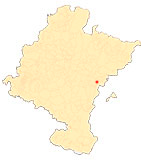The Gateway of Santa María de Sangüesa
By Clara Fernández-Ladreda Aguadé
|
THE ARTISTS. THE WORKSHOP OF SAN JUAN DE LA PEÑA AND THE WORKSHOP OF SCHEMATIC FIGURES |
|
Chronology
The Sangüesina façade was carried out in three phases, closely linked to the architectural campaigns of the temple.
In the first phase, most of the work was executed, specifically the entire door and the sculptures of the buttresses and almost all of the spandrels -except for the highest ones-, that is, the area that we attribute to Leodegario and his workshop. This first phase is dated more or less between the years 1160 and 1170, although it is possible that it lasted a little longer. The limits are given respectively by the chronology of the tomb of Doña Sancha in Nájera (1156-1158), considered the first Hispanic realization of the workshop, and the arches of the interior of the apse of San Martín de Uncastillo (1170-1179), whose execution would force the team to move to the town of Zaragoza, although some of its members could have continued working in Sangüesa. It should also be taken into account that the two capitals of the main chapel attributed to Leodegario's workshop, due to their status, must have been placed at the end of the first construction campaign -in which the chancel and the section of the south wall next to it would have been built- dated ca. 1160, which would reinforce the dating proposal, within that decade.
The second phase corresponds to the intervention of the so-called workshop of San Juan de la Peña, to which we owe the sculptures of the upper part of the façade, that is, those located in the highest part of the spandrels and those of the frieze, plus the westernmost modillion of the eaves. It could be placed in the decade of 1190, with a possible durability in the early years of the 13th century. This chronology would be supported by the dating of the second construction campaign -in which the remaining perimeter walls of the body of the naves were erected-, within the last quarter of the 12th century and in the years immediately after, since this workshop carved at least two of the capitals of this sector of the building. From there, the dates attributed to other works of the San Juan de la Peña workshop allow us to be a little more precise, leading us to think that its intervention in Sangüesa must have taken place at the end of the aforementioned campaign.
The third stage would be dated ca. 1200-1230 and would coincide with the participation of the workshop of the schematic figures, to which we owe the finishing of the whole, that is, the modillions of the eaves -except the one attributed to the workshop of San Juan de la Peña-, with whose execution the monumental doorway of Sangües can be considered finished. Again, this chronology is based on that of the third construction campaign, carried out during the first third of the 13th century, in which the four large central pillars were erected and the body of the naves was almost entirely vaulted, since the workshop participated in it by carving part of the capitals of the aforementioned supports.












